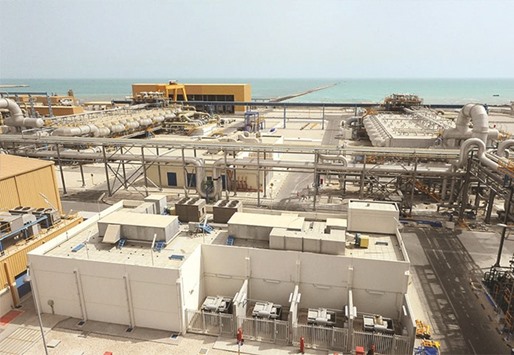Qatar Electricity and Water Company’s (QEWC) capital expenditure (capex) is slated to increase substantially to QR7.6bn ($2bn) in 2016-18 against a total QR1.6bn spend during 2012-14, according to Moody’s, a global credit rating agency.
“QEWC’s capex has increased to QR1.03bn in 2015 from QR0.76bn in 2014 due to the completion of RAF A2 and is expected to increase substantially in the 2016-2018 period to QR7.6bn,” it said in a report.
This increase is reflective of QEWC’s new phase of investments in the construction of RAF A3 and Umm Al Houl Power Plant.
QEWC’s adjusted debt to book cap is expected to rise in the next couple of years to above 72% in 2016 compared to 66.7% in 2013, it said, adding this outlines its weaker financial profile relative to global peers that similarly benefit from a high level of contracted revenues, reported Gulf Times.
Current low reserve levels in Qatar (power at 16% and water at only 6%) support the current wave of capex with two new plants to be commissioned, following the completion of RAF A2 in July 2015 which added 36 MIGD (million gallons per day) of water supply.
The commissioning of RAF A3 in two phases expected in September 2016 and January 2017 and Facility D in multiple phases expected in 2017 and 2018 will add another 172 MIGD of water supply and 2,520 MW of power supply.
Although QEWC is permitted to incur more debt under current financing arrangements, Moody’s said it has a self-assigned financial policy target of debt to capitalisation in the 60%-80% range.
Terming QEWC as “strategically” important to Qatar’s power sector, Moody’s said together with IPPs/IWPPs (independent power project/independent water and power project) partners, QEWC owns, operates and manages Qatar’s entire power and water generating assets.
QEWC’s position is further bolstered by a sovereign ruling that it will be allocated a minimum of 60% of any future power and water project in Qatar. This applies to current projects under construction, Facility D, which will be 60%-owned and RAF A3, which will be 100% owned by it.
Highlighting that fuel costs are and will remain the major component of QEWC’s cost base, Moody’s said variable costs linked to the actual running of the plants are covered by output charges as per the agreed tariff.
Although QEWC exhibits a “very high” level of concentration of its fuel base as its generating assets are all gas-fired, the agency said “however, we view the exposure to price shock as negligible.”
QEWC is not exposed to spot markets since gas is exclusively sourced from Qatar Petroleum under agreements that have a matching duration to that of the purchase deals for each plant, Moody’s said, adding QEWC can fully pass through the price of gas to Kahramaa under PPAs (power purchase agreements) as long as plants can meet the agreed heat rates.
The ability to maintain stable availability and cost pass through have resulted in QEWC’s reported Ebitda (earnings before interest taxes depreciation amortisation) margin stay above 50% over the past five years, although both capacity and revenue have significantly increased over the same period.
Moody’ said the majority of QEWC’s Ebitda comes from capacity charges under purchase pacts as Kahramaa has to make the ensuing payment irrespective of actual output as long as the plants are operationally able to meet the contractually agreed capacity.
The availability payments are designed to cover the fixed operating costs, investments costs (covering the capital invested for the construction phase), an agreed return on equity and comprehensive debt servicing (interest and principal/amortisation payments), it said.

